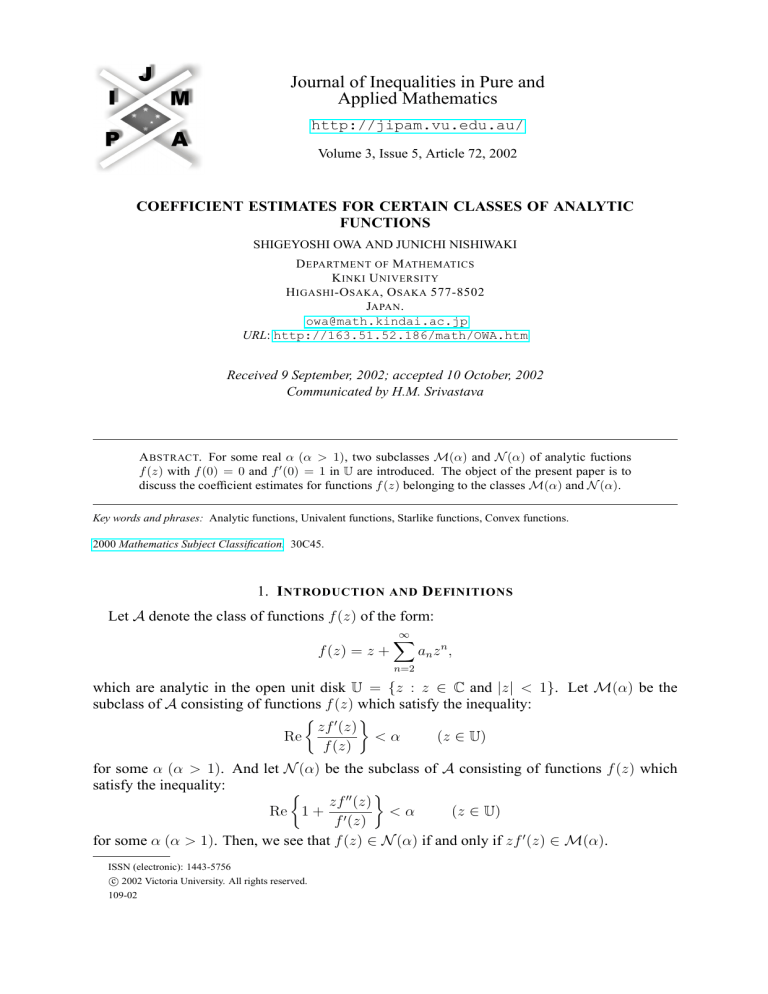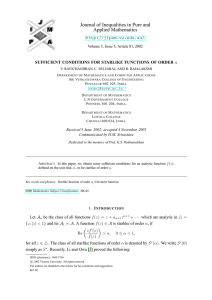
Journal of Inequalities in Pure and
Applied Mathematics
http://jipam.vu.edu.au/
Volume 3, Issue 5, Article 72, 2002
COEFFICIENT ESTIMATES FOR CERTAIN CLASSES OF ANALYTIC
FUNCTIONS
SHIGEYOSHI OWA AND JUNICHI NISHIWAKI
D EPARTMENT OF M ATHEMATICS
K INKI U NIVERSITY
H IGASHI -O SAKA , O SAKA 577-8502
JAPAN .
owa@math.kindai.ac.jp
URL: http://163.51.52.186/math/OWA.htm
Received 9 September, 2002; accepted 10 October, 2002
Communicated by H.M. Srivastava
A BSTRACT. For some real α (α > 1), two subclasses M(α) and N (α) of analytic fuctions
f (z) with f (0) = 0 and f 0 (0) = 1 in U are introduced. The object of the present paper is to
discuss the coefficient estimates for functions f (z) belonging to the classes M(α) and N (α).
Key words and phrases: Analytic functions, Univalent functions, Starlike functions, Convex functions.
2000 Mathematics Subject Classification. 30C45.
1. I NTRODUCTION AND D EFINITIONS
Let A denote the class of functions f (z) of the form:
f (z) = z +
∞
X
an z n ,
n=2
which are analytic in the open unit disk U = {z : z ∈ C and |z| < 1}. Let M(α) be the
subclass of A consisting of functions f (z) which satisfy the inequality:
0 zf (z)
<α
(z ∈ U)
Re
f (z)
for some α (α > 1). And let N (α) be the subclass of A consisting of functions f (z) which
satisfy the inequality:
zf 00 (z)
Re 1 + 0
<α
(z ∈ U)
f (z)
for some α (α > 1). Then, we see that f (z) ∈ N (α) if and only if zf 0 (z) ∈ M(α).
ISSN (electronic): 1443-5756
c 2002 Victoria University. All rights reserved.
109-02
2
S HIGEYOSHI OWA AND J UNICHI N ISHIWAKI
Remark 1.1. For 1 < α ≤ 34 , the classes M(α) and N (α) were introduced by Uralegaddi et
al. [3].
Remark 1.2. The classes M(α) and N (α) correspond to the case k = 2 of the classes Mk (α)
and Nk (α), respectively, which were investigated recently by Owa and Srivastava [1].
We easily see that
Example 1.1.
(i) f (z) = z(1 − z)2(α−1) ∈ M(α).
1
(ii) g(z) = 2α−1
{1 − (1 − z)2α−1 } ∈ N (α).
2. I NCLUSION T HEOREMS I NVOLVING C OEFFICIENT I NEQUALITIES
In this section we derive sufficient conditions for f (z) to belong to the aforementioned function classes, which are obtained by using coefficient inequalities.
Theorem 2.1. If f (z) ∈ A satisfies
∞
X
{(n − k) + |n + k − 2α|} |an | 5 2(α − 1)
n=2
for some k (0 5 k 5 1) and some α (α > 1), then f (z) ∈ M(α).
Proof. Let us suppose that
∞
X
(2.1)
{(n − k) + |n + k − 2α|} |an | 5 2(α − 1)
n=2
for f (z) ∈ A.
It suffices to show that
zf 0 (z)
−k
f (z)
zf 0 (z)
− (2α −
f (z)
k)
<1
(z ∈ U).
We note that
zf 0 (z)
−k
f (z)
zf 0 (z)
− (2α −
f (z)
P
1−k+ ∞
(n − k)an z n−1
Pn=2
=
n−1
1 + k − 2α + ∞
k)
n=2 (n + k − 2α)an z
P
n−1
1−k+ ∞
n=2 (n − k)|an ||z|
P∞
5
2α − 1 − k − n=2 |n + k − 2α| |an ||z|n−1
P
1−k+ ∞
n=2 (n − k)|an |
P∞
<
.
2α − 1 − k − n=2 |n + k − 2α| |an |
The last expression is bounded above by 1 if
∞
∞
X
X
1−k+
(n − k)|an | 5 2α − 1 − k −
|n + k − 2α| |an |
n=2
n=2
which is equivalent to our condition:
∞
X
{(n − k) + |n + k − 2α|}|an | 5 2(α − 1)
n=2
of the theorem. This completes the proof of the theorem.
If we take k = 1 and some α 1 < α 5 23 in Theorem 2.1, then we have
J. Inequal. Pure and Appl. Math., 3(5) Art. 72, 2002
http://jipam.vu.edu.au/
C OEFFICIENT E STIMATES FOR A NALYTIC F UNCTIONS
3
Corollary 2.2. If f (z) ∈ A satisfies
∞
X
(n − α)|an | 5 α − 1
n=2
for some α 1 < α 5 23 , then f (z) ∈ M(α).
Example 2.1. The function f (z) given by
f (z) = z +
∞
X
n=2
4(α − 1)
zn
n(n + 1)(n − k + |n + k − 2α|)
belongs to the class M(α).
For the class N (α), we have
Theorem 2.3. If f (z) ∈ A satisfies
(2.2)
∞
X
n(n − k + 1 + |n + k − 2α|)|an | 5 2(α − 1)
n=2
for some k (0 5 k 5 1) and some α (α > 1), then f (z) belongs to the class N (α).
Corollary 2.4. If f (z) ∈ A satisfies
∞
X
n(n − α)|an | 5 α − 1
n=2
3
2
for some α 1 < α 5 , then f (z) ∈ N (α).
Example 2.2. The function
∞
X
4(α − 1)
f (z) = z +
zn
2
n
(n
+
1)(n
−
k
+
|n
+
k
−
2α|)
n=2
belongs to the class N (α).
Further, denoting by S ∗ (α) and K(α) the subclasses of A consisting of all starlike functions
of order α, and of all convex functions of order α, respectively (see [2]), we derive
3
5
,
Theorem 2.5. If f (z) ∈A satisfies the coefficient inequality (2.1) for some α 1 < α 5 k+2
2
2
∗ 4−3α
then f (z) ∈ S 3−2α . If f (z) ∈ A satisfies the coefficient inequality (2.2) for some α
3
4−3α
1 < α 5 k−2
5
then
f
(z)
∈
K
.
2
2
3−2α
5 32 , we see that the coefficient inequality (2.1) implies that
Proof. For some α 1 < α 5 k+2
2
∞
X
(n − α)|an | 5 α − 1.
n=2
It is well-known that if f (z) ∈ A satisfies
∞
X
n−β
n=2
1−β
|an | 5 1
for some β (0 5 β < 1), then f (z) ∈ S ∗ (β) by Silverman [2]. Therefore, we have to find the
smallest positive β such that
∞
∞
X
X
n−β
n−α
|an | 5
|an | 5 1.
1−β
α−1
n=2
n=2
J. Inequal. Pure and Appl. Math., 3(5) Art. 72, 2002
http://jipam.vu.edu.au/
4
S HIGEYOSHI OWA AND J UNICHI N ISHIWAKI
This gives that
β 5
(2.3)
(2 − α)n − α
n − 2α + 1
for all n = 2, 3, 4, · · · . Noting that the right-hand side of the inequality (2.3) is increasing for
n, we conclude that
4 − 3α
,
β5
3 − 2α
which proves that f (z) ∈ S ∗ 4−3α
. Similarly, we can show that if f (z) ∈ A satisfies (2.2),
3−2α
4−3α
then f (z) ∈ K 3−2α .
Our result for the coefficient estimates of functions f (z) ∈ M(α) is contained in
Theorem 2.6. If f (z) ∈ M(α), then
(2.4)
|an | 5
Πnj=2 (j + 2α − 4)
(n − 1)!
(n = 2).
Proof. Let us define the function p(z) by
α−
p(z) =
zf 0 (z)
f (z)
α−1
for f (z) ∈ M(α). Then p(z) is analytic in U, p(0) = 1 and Re(p(z)) > 0 (z ∈ U). Therefore,
if we write
∞
X
p(z) = 1 +
pn z n ,
n=1
then |pn | 5 2 (n = 1). Since
αf (z) − zf 0 (z) = (α − 1)p(z)f (z),
we obtain that
(1 − n)an = (α − 1)(pn−1 + a2 pn−2 + a3 pn−3 + · · · + an−1 p1 ).
If n = 2, then −a2 = (α − 1)p1 implies that
|a2 | = (α − 1)|p1 | 5 2α − 2.
Thus the coefficient estimate (2.4) holds true for n = 2. Next, suppose that the coefficient
estimate
Qk
j=2 (j + 2α − 4)
|ak | 5
(k − 1)!
is true for all k = 2, 3, 4, · · · , n. Then we have that
−nan+1 = (α − 1)(pn + a2 pn−1 + a3 pn−2 + · · · + an p1 ),
J. Inequal. Pure and Appl. Math., 3(5) Art. 72, 2002
http://jipam.vu.edu.au/
C OEFFICIENT E STIMATES FOR A NALYTIC F UNCTIONS
5
so that
n|an+1 | 5 (2α − 2)(1 + |a2 | + |a3 | + · · · + |an |)
Πnj=2 (j + 2α − 4)
(2α − 2)(2α − 1)
5 (2α − 2) 1 + (2α − 2) +
+ ··· +
2!
(n − 1)!
(2α − 1)2α(2α + 1) · · · (2α + n − 4)
= (2α − 2)
(n − 2)!
(2α − 2)(2α − 1)2α · · · (2α + n − 4)
+
(n − 1)!
n+1
Πj=2 (j + 2α − 4)
=
.
(n − 1)!
Thus, the coefficient estimate (2.4) holds true for the case of k = n + 1. Applying the mathematical induction for the coefficient estimate (2.4), we complete the proof of Theorem 2.6. For the functions f (z) belonging to the class N (α), we also have
Theorem 2.7. If f (z) ∈ N (α), then
Qn
j=2 (j + 2α − 4)
|an | 5
(n = 2).
n!
Remark 2.8. We can not show that Theorem 2.6 and Theorem 2.7 are sharp. If we can prove
that Theorem 2.6 is sharp, then the sharpness of Theorem 2.7 follows.
R EFERENCES
[1] S. OWA AND H.M. SRIVASTAVA, Some generalized convolution properties associated with certain subclasses of analytic functions, J. Ineq. Pure Appl. Math., 3(3) (2002), Article 42. [ONLINE
http://jipam.vu.edu.au/v3n3/033_02.html]
[2] H. SILVERMAN, Univalent functions with negative coefficients, Proc. Amer. Math. Soc., 51
(1975), 109–116.
[3] B.A. URALEGADDI, M.D. GANIGI AND S.M. SARANGI, Univalent functions with positive coefficients, Tamkang J. Math., 25 (1994), 225–230.
J. Inequal. Pure and Appl. Math., 3(5) Art. 72, 2002
http://jipam.vu.edu.au/







